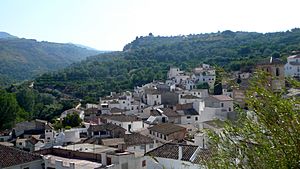Saleres facts for kids
Saleres is a small village in Spain. It is part of the El Valle municipality, located in the Granada province of Andalusia. You can find Saleres in the southern part of the Lecrín Valley. It is close to other villages like Restábal, Melegís, La Loma, Albuñuelas, and Pinos del Valle.
Saleres has a unique layout with narrow streets and courtyards. This design comes from its Muslim history and means cars cannot easily pass through. About 165 people live here. They grow crops like olives, citrus fruits, and almonds.
Contents
Discovering Saleres: Top Sights
Saleres offers some amazing views and places to explore. You can enjoy the sight of the village itself, nestled in a green valley. The Saleres River flows through this valley, making it very lush. Locals call this river "The Saint" because of an old story. It is said to always have plenty of water, even when there is a drought.
You can also explore the nearby mountains, known as the Sierra. An old path leads up to it. There, you might find the "Fountain of the Seven Years'," a special spring.
Saleres Through Time: A Brief History
The history of Saleres is connected to other towns in the Lecrín Valley. People first settled here a very long time ago, even before recorded history. They chose this area because it had water, fruits, animals for hunting, and good places to defend themselves.
Muslim Influence and Farming Innovations
Muslim people lived in Saleres for many centuries. Even with conflicts, they greatly improved farming. They brought new crops and created better ways to water the land. The water systems they built are still used today, with only small changes. During this time, the Lecrín Valley might have had around 7,000 people living in it.
In 1491, Christian troops came to the Valley. This was during the time when Boabdil, the last Muslim ruler of Granada, was surrendering. After Granada fell in 1492, the people of the Valley, known as Mudejars, continued to live and farm their land.
Changes and Challenges for the People
Around Christmas in 1499, some people rebelled against the Spanish Crown. They felt the agreements made when Granada surrendered were broken. They were also pressured to become Christian. Because of this, they were forced to convert and be baptized.
After several wars in the Kingdom of Granada, King Felipe II ordered the expulsion of the Moors from the Lecrín Valley in 1570. This meant many people had to leave their homes.
The Village Church and Natural Disasters
The building that was once the Saleres Mosque became a church after the Christian conquest. It was built between 1558 and 1562. Sadly, this church fell down in 1683. A new church was quickly built so people could continue their religious services.
After the Moorish population was sent away, 43 new settlers arrived. They were given plots of land to farm. In 1780, a big river flood destroyed 38 houses. About a century later, the village suffered from a large earthquake that affected Andalusia. There was also a cholera sickness and a plant disease called phylloxera, which ruined all the vineyards.
In the first half of the 1900s, the population of Saleres grew. By 1960, there were 587 people. They carefully farmed the terraced fields, which could be reached by mule or on foot.
Becoming Part of El Valle
Saleres used to be its own independent local government. But in 1972, it joined with Restábal and Melegís to form one larger municipality called El Valle.
Saleres Celebrates: Local Festival
Saleres has a special festival to honor St. James and Our Lady of the Rosary. This celebration usually takes place on October 28th. Before the main church service, there is often a religious procession through the village.
See also
 In Spanish: Saleres para niños
In Spanish: Saleres para niños


